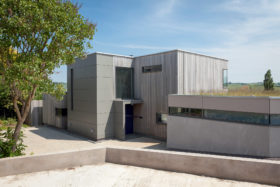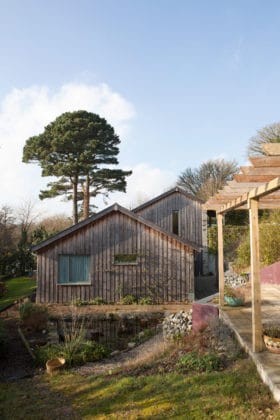

Some self builders – and planning departments – are keen on the look of one-and-a-half storey houses.
Sometimes referred to as storey-and-a-half or chalet/dormer bungalows, as the names imply, these properties feature rooms positioned between the ceiling of the first storey and the roofline, without full-height walls on the upper level. The second storey benefits from either dormers, rooflights or gable ends with windows.
As this is a popular design, we’re comparing the price of what it would cost to build a one-and-a-half storey in comparison to a full two-storey house. Each hypothetical property that we’re costing up has an 150m2 internal floor area. But before we get stuck in to figures, let’s take a look at the pros and cons of a one-and-a-half-storey home.
Planners often prefer a one-and-a-half-storey design because they are less physically imposing than a two-storey building. They are often considered a better fit for rural settings or on plots among bungalows.
From an aesthetic standpoint, the external structure of a one-and-a-half-storey building can add character. Whether that’s the greater roof-to-wall ratio, attractive dormers or a windowed gable end. So, for a one-off self build dwelling this design could make the end result more saleable.
The internal vaulted space upstairs offers something a little out of the ordinary, so is popular with homeowners looking to create a statement area, such as a master bedroom suite.
Timber frame dormer bungalowMark and Sheila Hemingway have self built a four-bedroom Potton home in Northamptonshire. The couple faced strict planning guidelines for the look of their property and have ended up with a contemporary cottage style. The house is 195m2 and the build cost came in at £298,650 – 5% over budget. “I appointed the subcontractors,” says Mark. “I also carried out some tasks myself, such as clearing away materials, minor joinery and preparations for the first fix electrical work – basically anything I thought I could do without getting in the way of the professionals.”
|
For some self builders, the idea of having a larger living space on the ground floor can be appealing.
Homeowners keen to avoid climbing stairs can have their master bedroom on the enlarged ground floor, with guest bedrooms upstairs for when family or friends stay over.
As with most loft conversions, you will have sloped ceilings on the upper storey. The walls upstairs could reach only 4ft or lower before sloping, so you need to think around the practicalities of that because headroom and storage opportunities can be compromised.
If you’re considering a one-and-a-half-storey design over a bungalow, then be aware you’ll need to make room for the staircase, which will eat into the living space downstairs.
With upstairs rooms positioned into the roof and fewer outside walls for windows, lighting can be reduced unless sufficient lighting is added into the roof or dormers are built.
Scottish cottage self buildLiberty and Hamish Martin were inspired by traditional, local styles for their self build just outside of Edinburgh. “I wanted a typical Scottish cottage that would look like it had been extended to one-and-a-half storeys with dormer windows,” says Liberty. “It would be a period-style new build home that would blend with the Lothian vernacular architecture.” The property is 235m2 and cost £372,995 to build, which comes in at £1,587 per m2.
|
The upstairs will be smaller than the ground floor. This is probably the single biggest differentiating factor between the two. When you calculate the saleable cost, you need to consider the useable area of the upper floor.
To make a fair comparison of a one-and-a-half-storey home with a two-storey, both are 150m2 with four bedrooms, one bathroom, one ensuite, one cloakroom, kitchen, dining room and lounge. We have assumed a builder’s mark-up (profit) of 30%.
The costs on the left include all aspects of the building fabric – plastering and decoration, plumbing and electrics, kitchen and bathroom fit out. The design is based on rendered block cavity walls, softwood windows and doors, as well as fibre cement slate roofing.
|
Allowances have been made for scaffolding, site set up and cleaning up fees. Internal flooring, planning prices and fees are not included.
A separate allowance for drainage, landscaping and other external works have been made as these are site specific.
As we have set out to achieve the same m2 in both houses, we’ve had to increase the building footprint of the one-and-a-half-storey. This means we’ve been able to maintain the same internal floor space due to the loss of upstairs floor area at the eaves. Useable floor space has been defined as sloping ceilings with more than or equal to 1.2m head height.
This has left side voids of 28.6m2, 60% of which could be used for storage. This has increased the size and cost of the foundations, slab and downstairs external walls, cancelling out much of the savings accrued by not building upper floor external walls in the one-and-a-half-storey house.
Plus there are the costs of the dormers and the rooflights.
These reasons have meant that the one-and-a-half-storey in this example is more expensive to build than the two-storey, albeit marginally. So it suggests that the dormer bungalow isn’t going to save you cash. But then for most, it’s more about easy living and interesting design.

